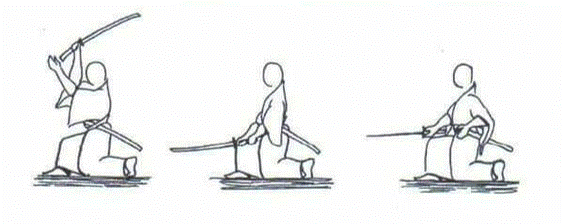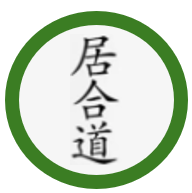04. YONHON ME 四本目
TSUKA ATE 柄当て
Striking with the hilt
Two people, one in front and the other behind intend to attack you. Thrust the pommel of your sword into the front opponent's solar plexus, then draw and stab the rear opponent. While turning back to the front bring the sword downward from above the head in a vertical action to defeat the first opponent.
a] Sit in the Iai Hiza position (1) and face the front. Swiftly place both hands on the sword and raise your hips. Put strength in your left toes and place them at the rear of the left knee as you raise yourself. Whilst moving forwards with the right foot, strike the opponent's solar plexus with the Tsukagashira (pommel of handle) , making a thrusting action with the sword still in the Saya.
(1) After taking Taito Shisei, tuck the hem of the Hakama clear of the ankles and bend both knees. Lower the left knee to the floor and bring the right foot up to the side of it and flatten the left foot. Ensure the right knee is pointing to your diagonal right and sit naturally placing the buttocks on the left heel. Close the hands to form loosely clenched fists and place them on the middle of your thighs. Assume the same manner as that found in Seiza No Shisei.
b] While drawing back the sheath with your left hand, turn and look towards the opponent at your rear. The left leg moves 90 degrees by turning anticlockwise, pivoting on the left knee. Turn left and at the same time draw the sword and bring the Mune near the Monouchi to rest on your chest. The edge of the blade should be facing away from you. Extend the right arm and thrust to the solar plexus of the opponent at your rear. Ensure the tip of the sword is horizontal and in line with the centerline of your opponent. Simultaneously bring your left hand back to your center turning the Saya into an upright position. Keep it in contact with your body until the Koiguchi stops in front of your navel.

● When the sword is unsheathed for the Tsuki, it rests in contact with the plexus at the half (back) of the blade. The pike is made by starting to move the left hand before the right with the action of Chiburi (left hand at the navel with a clockwise rotation); this is to avoid a shock between Tsuba/left hand. During the Tsuki, the Tsuka will be positioned under the right forearm. At the end of the Noto, the body will pivot slightly to the right (a bit like in Koryu).
c] Face the front opponent by rotating the left leg back onto its original line using lhe left knee as an axis. At the same time bring the sword above the head with a natural feeling of pulling it out of the opponent's body. Place your left hand on the hilt and cut the opponent downwards in the same manner as described in Mae.

d] Without changing your posture release the left hand from the hilt and place it on the left hip over the belt. At the same time execute a horizontal action to the right with your right hand Migi Ni Hiraite No Chiburi (Yoko Chiburi) . When shedding the blood from the sword your right fist should be at the same height as your left hand. Keep the tip of the sword inclined sightly inwards and a little lower than the horizontal level.
e] Take your left hand from the belt to the Koiguchi and perform Noto while bringing your front foot back in a straight line to finish near the other. While doing this, settle the hips into a Sonkyo position. Maintain an upright position facing the front with the left knee on the floor. Sit on both raised heels.

f] Bring your waist and right foot forward and stand up. As you do so, bring the rear foot forwards in line with the front foot. Release your right hand from the hilt, take Taito Shisei and return to your original position starting with your left foot.

● When the rear opponent is thrust, is this done with the right elbow extended fully and does the left hand bring the Koiguchi to the navel?
● When the cut is made, is it on the vertical centerline and from the correct position above the head?
